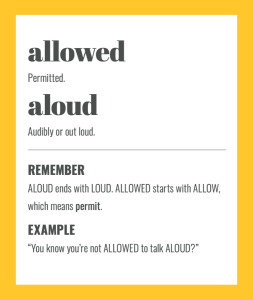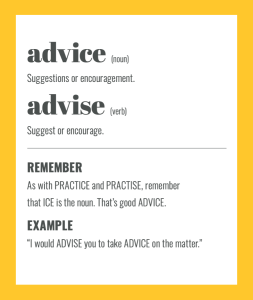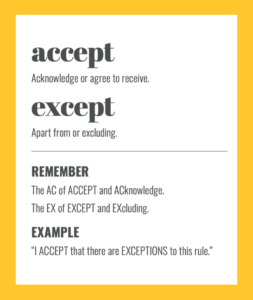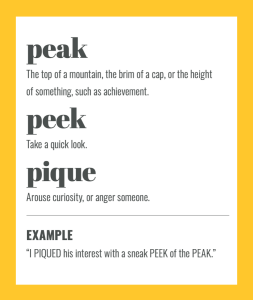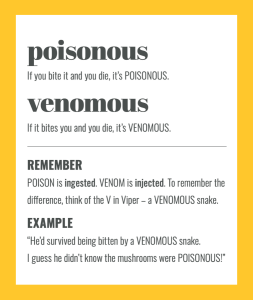Aloud vs allowed: top tips to remember the difference
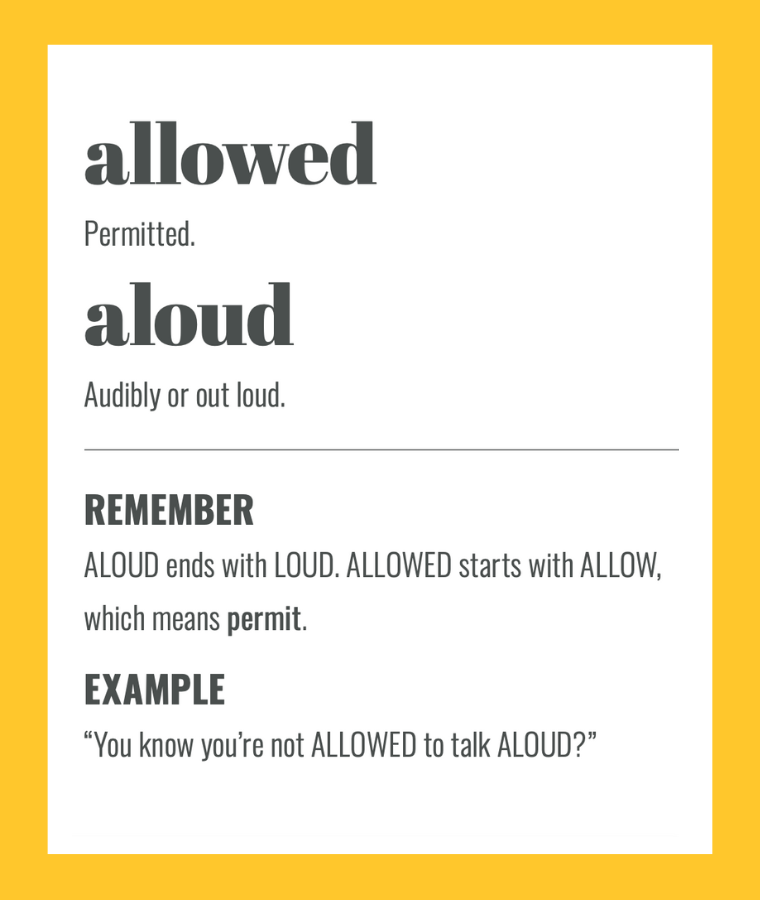
ALOUD vs ALLOWED: which is which? Tips and tricks to remember the difference.
ALOUD and ALLOWED are easy to confuse. The fact that the two words sound the same – they’re homophones – means people commonly mix them up.
Here are my simple tips to remember the difference between ALOUD and ALLOWED.
ALOUD means out loud. Remember that this spelling ends in LOUD.
“I’m just thinking ALOUD.”
ALLOWED means permitted. Remember it starts with ALLOW.
“You are ALLOWED to read ALOUD.”
In its verb form, ALLOWED is that past tense of ALLOW.
“She ALLOWED him to read ALOUD.”
Get more tips in The Little Book of Confusables
Advise vs Advice: top tips to remember the difference

ADVISE vs ADVICE: do you know the difference?
ADVISE and ADVICE are easy to confuse. The fact that they look so similar trips people up time and time again.
Here are my simple tips to remember the difference between ADVISE and ADVICE.
ADVISE is a verb that means suggest, encourage or tell someone to do something.
“I ADVISE you to learn the difference between ADVISE and ADVICE.”
ADVICE is a noun.
The best way to remember this is that it ends with ICE, which is also a noun:
“That’s good ADVICE.”
Understanding the difference between the ISE and ICE endings can help you to remember the spellings of other similar word pairs.
Think DEVISE (verb) and DEVICE (noun), or PRACTISE (verb) and PRACTICE (noun).
(Note that the latter applies to the British English spelling only – US English has its own rules.)
Get more tips in The Little Book of Confusables
Accept or except: do you know the difference?
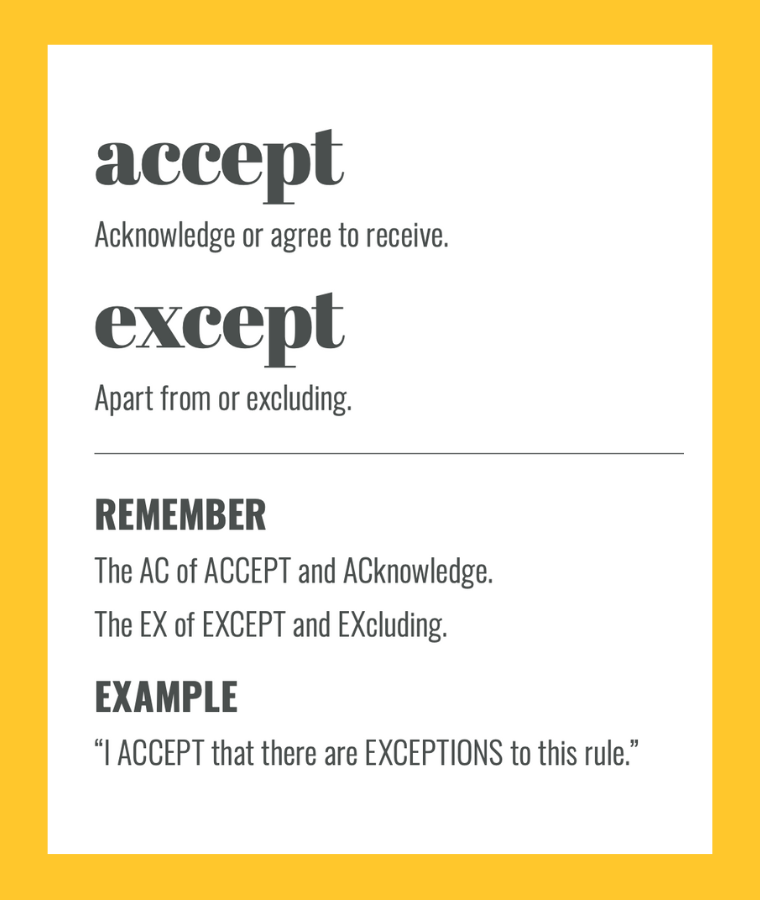
ACCEPT vs EXCEPT – simple tips to remember the difference
ACCEPT and EXCEPT are easy to confuse.
They may sound the same but they have different meanings… and I have a simple tip to remember the difference between them.
ACCEPT means to acknowledge, or agree to receive.
To remember this, think of the AC of ACCEPT and ACKNOWLEDGE.
EXCEPT means apart from, or excluding.
Think of the EX of EXCEPT and EXCLUDING.
Keep these tips in mind and you’ll stop making this common mistake in no time.
Get more tips in The Little Book of Confusables
Peak, peek or pique: simple tips to remember the difference

Peak vs peek vs pique: do you know the difference? These tips will show you how to use these commonly confused words.
Years ago there was an account on Twitter that automatically responded when people spelled ‘sneak PEEK‘ as ‘sneak PEAK‘.
I’m kinda disappointed it no longer exists (changing the world, one spelling tweet at a time is right up my streat… sorry – street).
But there’s no doubt these tricksy spellings are easy to confuse. Here are my top tips to remember the difference between PEEK and PEAK… with PIQUE thrown in for good measure.
When to use PEAK
It’s easy to remember that the PEAK is the top or pinnacle of something. Just think of the A being like the top of a mountain.
When to use PEEK
A PEEK is a cheeky glance (or peep).
Think of the two EEs in CHEEKY, and the two EEs in PEEK – or like two eyes peeping.
When to use PIQUE
PIQUE means to arouse curiosity, or to make someone angry.
You might do something in a fit of PIQUE, but never ‘a fit of PEEK‘ or ‘a fit of PEAK‘ – though you need to be fit to climb a PEAK (sorry – couldn’t resist).
Get more tips in The Little Book of Confusables
Fun, memorable spelling and usage tips for 600 commonly confused words, packed into 300+ gorgeous pages for just £11.95. You’ll wonder how you managed without it!
2023 GOLD award winner at the eLit book awards.
Poisonous vs venomous: do you know the difference?
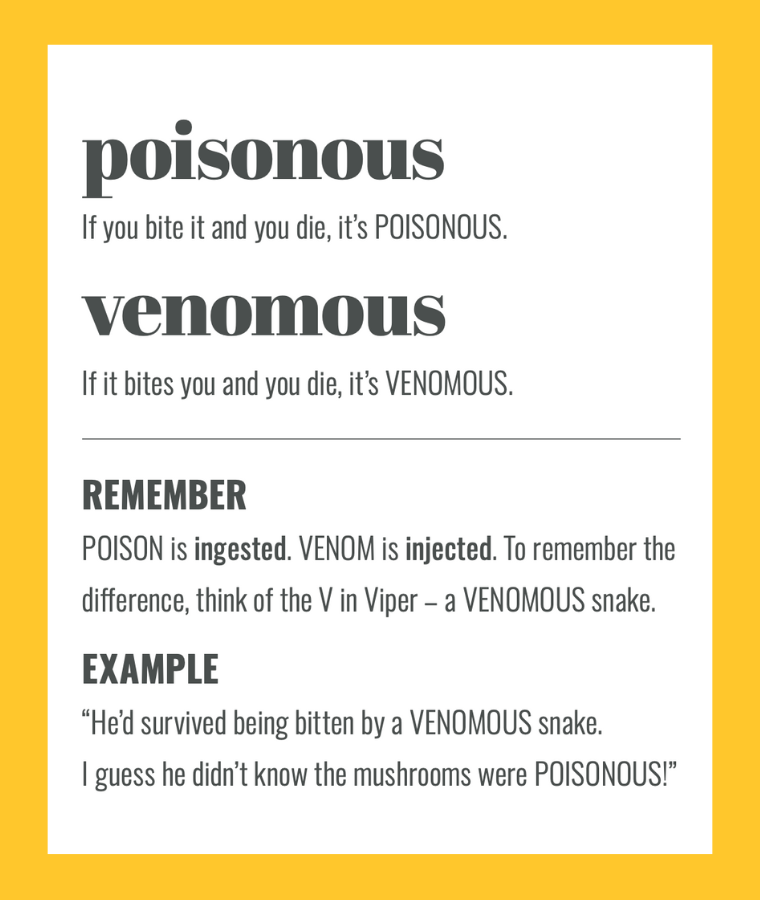
Poisonous vs venomous: wait – don’t they mean the same thing?!
I confess, until I heard someone explain the difference between the two adjectives, I thought they were synonymous.
They’re not!
Hopefully this tip – summed up in the visual below – will help you remember the difference.
You’ve probably heard people describe creatures such as snakes and spiders as POISONOUS: but unless you’re planning to eat them, VENOMOUS is more accurate.
POISONOUS is used to describe something that’s toxic if you ingest it. So, if you bite it and you die, it’s POISONOUS.
VENOMOUS creatures produce poison. If you’re bitten by a VENOMOUS snake, you could die.
(Don’t get me wrong – I have nothing against snakes, or spiders for that matter – I’m exaggerating to make a point, as a stronger mental image is more likely to make the trick stick in your mind.)
Get more tips in The Little Book of Confusables
POISONOUS vs VENOMOUS. Excerpt from The Little Book of Confusables by Sarah Townsend. Get simple spelling tips for 500+ commonly confused words.


